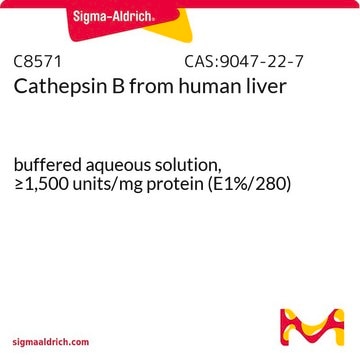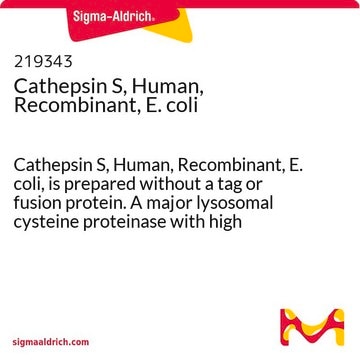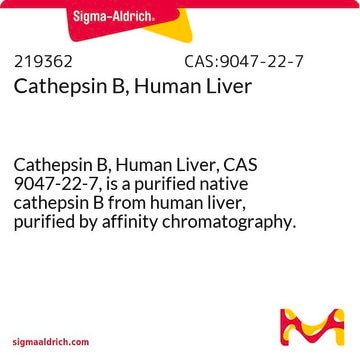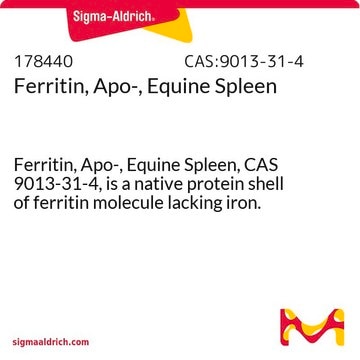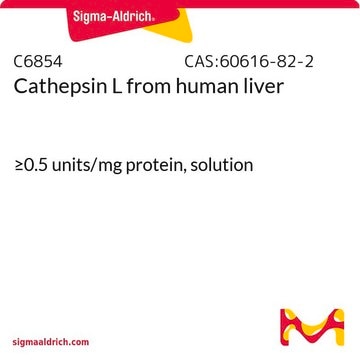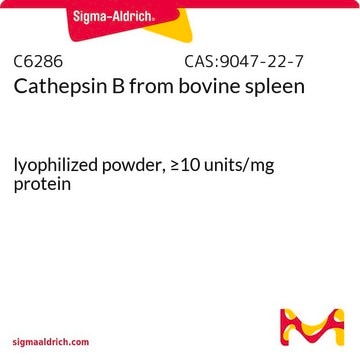219461
Cathepsin K, His•Tag®, Human, Recombinant, E. coli
Cathepsin K, His•Tag, Human, Recombinant, E. coli, CAS 94716-09-3, of the papain superfamily of cysteine proteinases plays a role in osteoclast-mediated bone resorption and collagen degradation.
Sign Into View Organizational & Contract Pricing
All Photos(1)
About This Item
CAS Number:
UNSPSC Code:
12352202
NACRES:
NA.77
Recommended Products
recombinant
expressed in E. coli
Quality Level
assay
≥95% (SDS-PAGE)
form
liquid
specific activity
≥900 mU/mg protein
manufacturer/tradename
Calbiochem®
storage condition
OK to freeze
avoid repeated freeze/thaw cycles
shipped in
wet ice
storage temp.
−70°C
General description
Cathepsin K is a member of the papain superfamily of cysteine proteinases and plays an important role in osteoclast-mediated bone resorption and collagen degradation. It is primarily expressed by osteoclasts and recent studies also suggest its expression in fibroblasts. Irregularities in cathepsin K activity, either too high or too low, contribute to osteopenic disorders such as osteoporosis and pycnodysostosis. This recombinant enzyme contains a C-terminal His•Tag sequence.
Cathepsin K is a member of the papain superfamily of cysteine proteinases and plays an important role in osteoclast-mediated bone resorption and collagen degradation. It is primarily expressed by osteoclasts. Recently reported to also be expressed in fibroblasts. Irregularities in activity contribute to osteopenic disorders such as osteoporosis and pycnodysostosis. Contains a C-terminal His•Tag.
Note: 1 mU = 1 milliunit.
Packaging
Please refer to vial label for lot-specific concentration.
Warning
Toxicity: Standard Handling (A)
Unit Definition
One unit is defined as the amount of enzyme that will hydrolyze 0.4 µmol Z-FR-AMC per min at 37°C, pH 5.5.
Physical form
In 50 mM NaOAC, pH 5.5. The activation was stopped by addition of 10 mM MMTS, which can be removed under reducing conditions.
Reconstitution
Following initial thaw, aliquot and freeze (-70°C).
Other Notes
Delaisse, J.M., et al. 2003. Microsc. Res. Tech.61, 504.
Dodds, R.A. 2003. Cell Biochem. Funct.21, 231.
Everts, V., et al. 2003. Calcif. Tissue Int.73, 380.
Hou, W.S., et al. 2003. Biol. Chem.384, 891.
Dodds, R.A. 2003. Cell Biochem. Funct.21, 231.
Everts, V., et al. 2003. Calcif. Tissue Int.73, 380.
Hou, W.S., et al. 2003. Biol. Chem.384, 891.
Legal Information
CALBIOCHEM is a registered trademark of Merck KGaA, Darmstadt, Germany
HIS TAG is a registered trademark of Merck KGaA, Darmstadt, Germany
wgk_germany
nwg
flash_point_f
Not applicable
flash_point_c
Not applicable
Certificates of Analysis (COA)
Search for Certificates of Analysis (COA) by entering the products Lot/Batch Number. Lot and Batch Numbers can be found on a product’s label following the words ‘Lot’ or ‘Batch’.
Already Own This Product?
Find documentation for the products that you have recently purchased in the Document Library.
Xiao-Yu Yuan et al.
Bioorganic & medicinal chemistry, 27(6), 1034-1042 (2019-02-19)
Selective proteinase inhibitors have demonstrated utility in the investigation of cartilage degeneration mechanisms and may have clinical use in the management of osteoarthritis. The cysteine protease cathepsin K (CatK) is an attractive target for arthritis therapy. Here we report the
Our team of scientists has experience in all areas of research including Life Science, Material Science, Chemical Synthesis, Chromatography, Analytical and many others.
Contact Technical Service